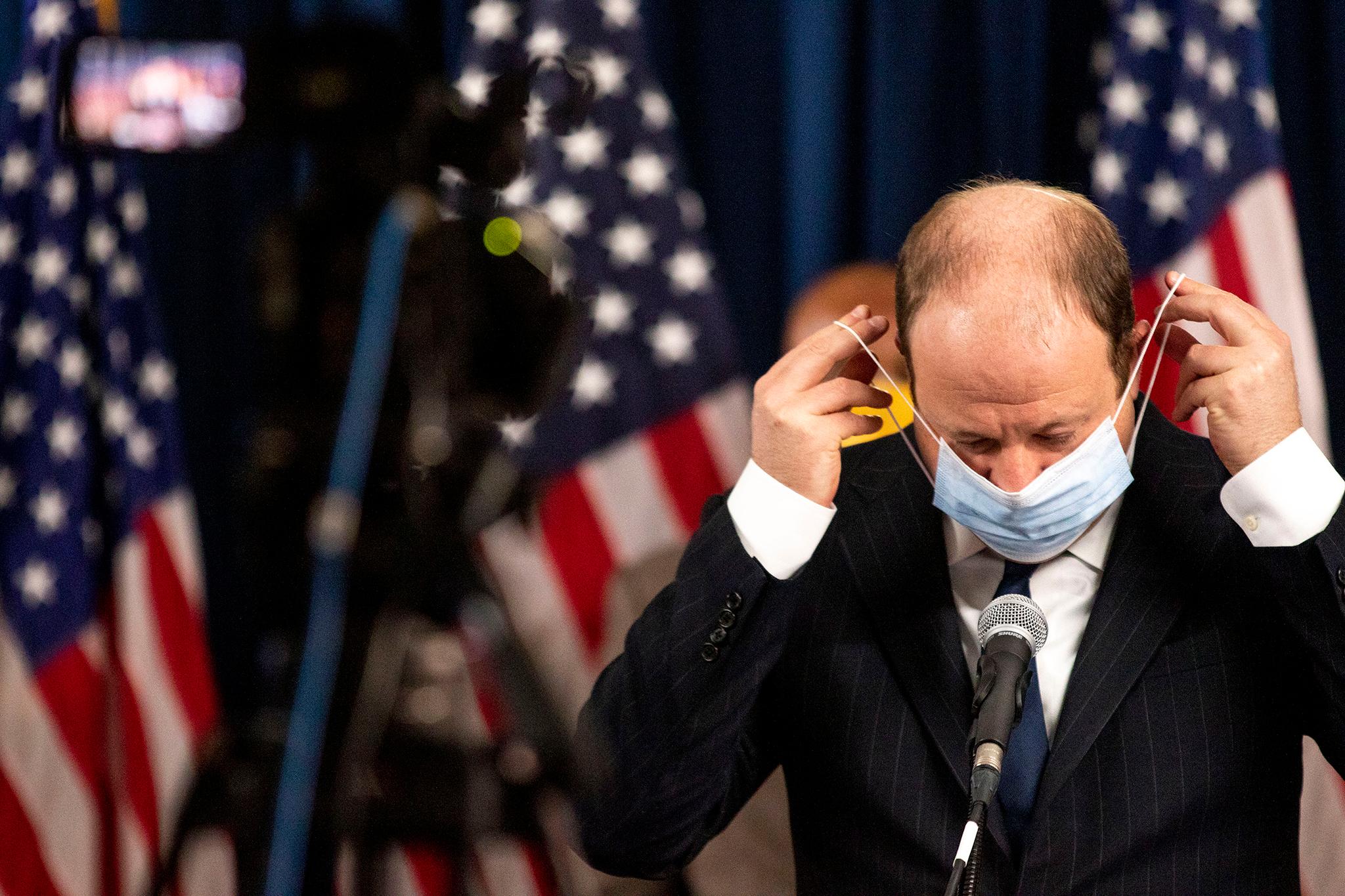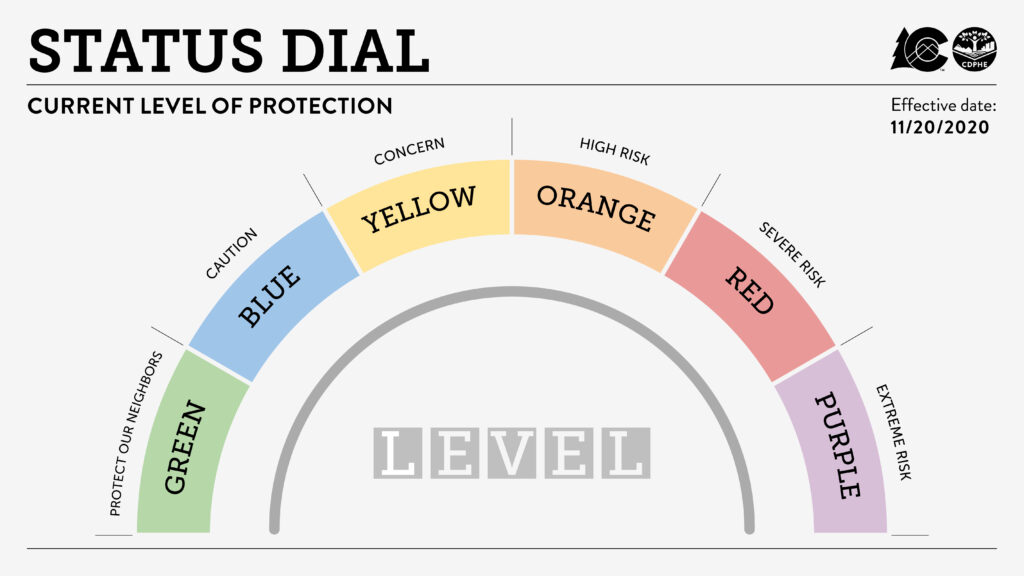
- Stimulus package: Colorado's special legislative session on Nov. 30 to address coronavirus relief
- Thanksgiving travel: CDC recommends not traveling for Thanksgiving but DIA remains busy
- Denver Broncos: No more in-person fans at home games after this weekend
Updated on Nov. 23 at 1:23 p.m.: The Colorado Department of Public Health and Environment notified El Paso County that beginning on Fri., Nov. 27 at 5 p.m., the county will be subject to tighter restrictions at "level red," detailed in the original story below.
Updated on Nov. 20 at 7:48 a.m.: On Nov. 19, the Colorado Department of Public Health and Environment alerted that beginning Sun., Nov. 22, 8 more counties will move towards tighter restrictions this weekend: Alamosa, Otero, Prowers, Pueblo and Weld will all move to level red — severe risk — and Baca, Bent and Kiowa will move to level orange — high risk. Our original story continues below.
Fifteen Colorado counties now sit at the second-highest level of the state’s newly adjusted restrictions.
The counties that will now see new rules like prohibitions on personal gatherings, a temporary halt to indoor dining at restaurants and more severe restrictions on office and gym capacity are: Adams, Arapahoe, Boulder, Broomfield, Clear Creek, Denver, Douglas, Jefferson, La Plata, Logan, Mesa, Morgan, Routt, Summit and Washington counties.
The new restrictions kick in on Nov. 20.

The Colorado Department of Public Health and Environment alerted another group of counties, Costilla, Custer, Lake, Montezuma, Pitkin and San Juan, that they'd be moving to a third most severe level on the same day. At that level, the COVID-19 numbers are going up, but not to the point where everything needs to be shut down and capacity limits are moderate.
The state health department released the list hours after Colorado Gov. Jared Polis held a news conference saying that 10 to 15 counties would likely be subject to new restrictions but didn't reveal which, other than Denver.
Polis that nationally, regionally and in Colorado, efforts to hold off the virus have proven insufficient.
“What we're doing isn't working, and we clearly need to take more mitigation measures. And, that's what we're doing today,” he said.
“It's a problem everywhere in our state,” Polis said.
He noted that in Adams County, one in 58 people are currently contagious with coronavirus; in Denver, it’s one out of 64; and in Arapahoe County, it’s one out of 83. Statewide, about one in 110 people are contagious with coronavirus.
Polis, Denver Mayor Michael Hancock and top lawmakers announced a new classification in the state’s COVID-19 “dial” that comes with rules that will ban dining inside restaurants — takeout and delivery will still be available — and will limit capacity in gyms to 10 percent.
The new dial has a major impact on certain areas, like gatherings, schools, gyms and restaurants. Under the new level, now the second-most severe, generally more activities are allowed, but under strict guidelines. That’s for counties with high levels of transmission, hospitalizations and positivity rates. Most indoor activities are prohibited or strictly limited and outdoor activities are encouraged as an alternative. The limits on capacity are significant.
Under the most severe level of the dial, certain activities are closed or severely restricted. That level is for counties where hospital capacity is at extreme risk of being overrun; businesses must “significantly curtail” in-person functions. and people must stay at home except for necessary activities, according to the health department.
What Colorado’s COVID-19 rules look like at the two most severe levels.
Under the new "severe risk" (red) level:
- Residents are asked to stay at home.
- Personal gatherings of any size are prohibited.
- Child care is open.
- Pre-school through 12th grade: preschool through fifth grade, in-person, hybrid or remote as appropriate; middle school, in-person, hybrid or remote suggested; high school, hybrid or remote suggested.
- Higher education: remote learning is suggested, with limited in-person when necessary.
- Places of worship and life rites functions: indoors, limited to 25 percent capacity or 50 people at indoor functions; outdoors, people must keep 6 feet of social distancing.
- Restaurants: indoor dining closed, outdoor/open-air dining with only groups of their own household.
- Last call: 8 p.m., on-premise.
- Non-critical manufacturing: 25 percent of capacity, up to 50 people.
- Bars: closed.
- Offices: 10 percent capacity; remote office work strongly encouraged.
- Gyms: 10 percent capacity with up to 10 people indoors per room. Outdoor groups must be less than 10. Reservations required.
- Group sports and camps: Virtual, or outdoors in groups of less than 10.
- Critical and non-critical retail: 50 percent capacity, increased curbside pickup and delivery. Dedicated hours for seniors and at-risk are encouraged.
- Personal services: 25 percent of capacity or 25 people.
- Limited health care settings: 25 percent of capacity or 25 people.
- Indoor events and entertainment: closed.
- Outdoor events and entertainment: 25 percent of capacity or 75 people, attended only with members of your own household, with 6 feet of spacing from other groups.
- Outdoor guided services: 25 percent of capacity, or fewer than 10 people.
Under the new "extreme risk" (purple) level:
- Residents are ordered to stay at home.
- Personal gatherings of any size are prohibited.
- Child care is open.
- School for all grades: in-person, hybrid or remote as appropriate.
- Higher education: remote suggested, with very limited in-person when necessary.
- Places of worship and life rites: Remote, virtual services or outdoor services are strongly encouraged. Indoor capacity is limited to 10 people. For outdoor services, 6 feet of distance between groups.
- Restaurants: Indoor and outdoor dining are closed. Takeout, delivery and to-go are available.
- Bars are closed.
- Last call: No service on-premise.
- Non-critical manufacturing: 10 percent of capacity, up to 25 people.
- Office work should be virtual or outdoors in groups of less than 10.
- Gyms/fitness, group sports and camps: Virtual or outdoors in groups of less than 10.
- Critical and non-critical retail: Curbside pickup and delivery.
- Personal services: closed
- Limited health care settings: 10 percent capacity, or 25 people.
- Indoor and outdoor events and entertainment: closed
- Outdoor guided services: 25 percent, up to 10 people only in your own household.
The governor sidestepped questions about whether the public might find the changes confusing.
“The dial is a powerful tool for mayors and commissioners, but for the general public, we really want to keep it simple,” he said. “There is a risk everywhere in our entire state.”
The change spotlighted the needle Polis and other top leaders are trying to thread. Hospitals are on the verge of a crisis not seen in many decades, perhaps since the last pandemic a century ago. COVID-19 patients are pouring in and staff shortages are looming. Meantime, without much-hoped-for federal relief, businesses, workers and families are facing their own financial crisis.
Hancock called on residents of the Denver area to step up.
“If we're going to reverse the trend, we must move now with additional measures before more drastic steps have to be taken,” Hancock said.
Polis encouraged schools to continue to teach kindergarten through fifth-grade students in person but advised that high school students should learn remotely.
“Right now, in the here and now, we in Colorado need to act to stop this exponential growth to save lives and save our economy,” Polis said.
Parkview Hospital in Pueblo reached more than 100 percent capacity Monday, according to the governor, and patients had to be transferred to other facilities.
The move comes with the state’s daily COVID-19 update revealing some of the most daunting numbers to date. Twenty-seven percent of Colorado hospitals reported that they expect staff shortages in the next week.
The state reported 1,378 patients hospitalized Tuesday, up 84 from the day before; 11 percent of facilities said they anticipated ICU bed shortages in the next week. The seven-day case average is still soaring to new records, at 4,499. Most days now the state is recording deaths in the double digits. The seven-day positivity is 12.59 percent, that's five days above 12, and well above the 5 percent threshold, which indicates trouble. But that figure hasn't yet pushed higher, so perhaps that data point is a glimmer of good news.
“Doctors, nurses, and hospital staff are once again carrying us on their shoulders,” Hancock said. “And we as individuals must step up to lessen the burden on them and everyone else.”








